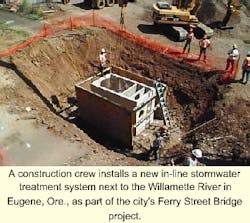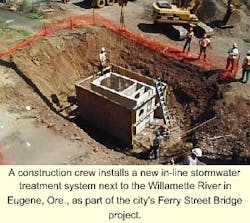Pilot Program Tests In-line Stormwater System
The forecast for Eugene, Ore.: Lots of rain, and a high probability of more stringent water quality regulations. In other words, perfect conditions for a pilot program to test the feasibility of an in-line stormwater treatment system.
Eugene (population 133,000) is nestled in the Willamette River valley on the west slopes of the Cascade Range.
Criteria and a location were established for the pilot program. The Ferry Street Bridge project, a $30 million, multi-year bridge renovation effort, provided an ideal site for the stormwater pilot program: the drainage basin is fairly small (just under 3 acres) but includes a high percentage of impervious area. The heavily developed transportation and commercial corridor (pre-project traffic counts averaged 64,000 vehicles a day) includes several automobile dealerships and an active gas station. These parking lots and adjacent roadways generate grease, oils, total suspended solids (TSS), and other removable loadings in stormwater runoff. Removing these pollutants is crucial, as the drainage area discharges directly to the Willamette River, which flows through the center of Eugene.
Eugene staff set three basic criteria for the stormwater treatment pilot program:
- It must provide some level of in-line water quality treatment.
- The structure must be able to be maintained using existing stormwater maintenance equipment.
- The design of the structure must be such that, even if maintenance were not supplied, the conveyance of the system would not be diminished from the level provided by a standard in-line manhole.
The Vortechstrademark Stormwater Treatment System 3000, manufactured by Vortechnics, Inc., of Portland, Maine, met the criteria and offered additional advantages. The model's shallow design was less expensive to install than more-vertical designs, and the structure provided capacity for large storm events. The structure is engineered to provide a net 80 percent TSS removal efficiency over the range of intensities in the design storm (4 cubic feet per second for a 50-year storm) without bypassing, even under backwater conditions.
Eugene purchased the system from Vortechnics and entered into a time and material arrangement with the Ferry Street Bridge contractor, Mowat Construction Co. of Kirkland, Wash., to have it installed. An area precast concrete firm fabricated the vault for the system.
The Vortechs System is designed with a combination of swirl-concentrator and flow-control technologies. The circular swirl chamber, or "grit chamber," channels influent into a slow vortex-like flow path, facilitating separation of settleable and floatable contaminants. A permanently submerged baffle wall prevents oil from escaping the system during storm events and cleanout. Custom-designed weir and orifice plates in the last chamber limit flow velocities to avoid turbulence, pollutant resuspension and washout, even at high storm intensities.
The first connections to the system were made in November 1998. For the next several years, Eugene Public Works staff will monitor the amount of sediment and other pollutants removed from the stormwater structure, evaluate maintenance efficiencies, and determine if other sites may be suitable for similar structures. Meaningful monitoring results are expected after the bridge construction is completed in early 2000.
For more information about the Ferry Street Bridge project and the water quality pilot program, visit the City of Eugene Internet site at www.ci.eugene.or.us.

